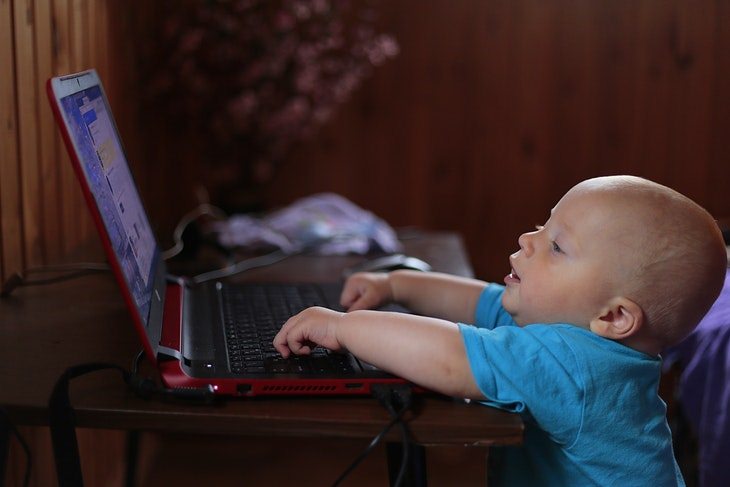Your goal as a parent or relative is to keep the balance between technology and real-life interactions. Even if your child is using technology for learning or creativity, limit their screen time, as it is essential for a child to develop physical and social skills to have a healthy and happy life. Here is what to do depending on the child’s age.
0-2 years
In this crucial period, the child’s core brain functions of language and learning are developing, so it is advisable to limit tech use altogether or keep it at a bare minimum. According to the American Association of Pediatrics, before the age of 2, the child should explore all of their senses and deal mostly with physical stimuli and limit tech use to video chatting with relatives who live far away.
Remember that devices should be kept out of kid’s bedrooms. There is scientific evidence that the light emitted from devices can interfere with your child’s sleep, so make sure they’re out the child’s reach 2 hours or so before bed time.
Even the smallest and cutest of children pick up on your habits, so you have to be the role model for your kids early on. Use devices as you’d like your children to use them. For example, don’t check your phone unless necessary during family time, such as meals, talks and outdoor activities. And if you do, don’t be surprised when your teenage child can’t take their eyes off the phone at breakfast.
When you do decide to slowly introduce the child to devices, try using interactive books or similar apps, and not just a distracting cartoon. Sing, read, explain and play with them together to stimulate their senses.
Also, make a rule for yourself as a parent not to use a device as a distractor for the child while you’re doing your chores, use toys instead.
We like such apps as Animal Sounds for Baby (Android link, IOS link), which you can use to teach your child the sounds of animals, but there are other good apps with music, songs, and interactive books available online, too.
It is also very important to use devices together with your young child (this also applies to older kids). This will not only give you control of what you do and how your child experiences technology, but also gives you a chance learn something and bond over this experience.
3-5 years
In this age range, your child will most likely get their real first hands-on experience with technology. At the same time, this is the time when your child learns how to socialize and connect with others. That is why you should focus on limiting screen time to no more than 1 hour a day and no more than 20-30 minutes per sitting.
To help your small child abide by the time restrictions, you can install parental control on all the devices to which the child has access. Alternatively, set a kitchen timer so that they could see, but not reach it (because if they can get their hands on it, they’ll learn to reset it pretty fast).
For mobile devices, you can limit screen time, set up restrictions for certain apps and locate your child with the help the Family Link app or similar for Android devices, and for Apple devices find “Restrictions” in the general settings of the device to limit apps and features.
For computers, make sure to set up a separate user for your child. You should also enable parental controls on your computer (called "Microsoft Family" on Windows, or "Parental Controls" on MacOS). Similarly, there is a variety of software, such as KidLogger and Qustodio that will make the kids’ Internet use safe, will let you set time limits and track your child’s activity.
There is also a kid-safe, ad-free search engine called Kiddle that you can set up on both mobile devices and pcs.
At the age from 3-6, using tech devices should encourage communicative and bonding behaviors, so it’s best if someone uses the device with them. You can take turns playing a game, explore a book or video, cooperate and learn together.
Games foster learning too, Fish School (Android link, IOS link), for example, is an interactive and fun way for your child to learn shapes, colors and the alphabet. Toka Kitchen (Android link, IOS link) teaches kids about ingredients and their combinations in cooking. And we barely scratched the surface, as there are thousands of apps and games available for free online.
To make sure that an app or game is suitable for your child, check the age rating of the game. It’s always a good habit to double-check the age restrictions offered on your app store or YouTube Kids before letting your child use it, too CommonSenseMedia is a reliable resource for such reviews.
And finally, don’t use a device as a reward for good behavior. The child shouldn’t perceive a device as a toy and only a toy.
6-12 years
The recommended screen time for schoolchildren is no more than 2 hours per day, with breaks every half an hour, because the fact that they may use the computer for schoolwork doesn’t mean they have stopped interacting with the real world, especially since they have to sit for hours at school already.
We trust you already set up a separate account for your child on the computer and enabled the parental controls. Now it’s time to have a safety conversation with your child. Explain to your child that they should never share any personal details or sensitive information with others online and that the Internet never forgets, so they shouldn’t be oversharing or rude.
Some interesting tools for older kids are Scratch, which an educational website created by MIT that teaches kids logical thinking through fun activities. If your child is into art, music and animation, try Toontastic (Android link, IOS link), an app that lets kids create their own cartoons. Cambridge Science (Android link, IOS link) and Science360 are fascinating tools that can teach your kids about nature and science (and one you can enjoy, too).
Now let’s move to a more pressing matter, one that haunts countless parents every night, when should your child have their own phone?
There is no set answer, and in general, it depends on how mature and trustworthy the child is. The average age in the US is 9 years as of 2017, but it decreases every year. The key question you should ask yourself is “will your child follow your rules of phone use when you’re not there to check”? The danger of your child being subjected to the distractions of social networks, cyberbullying, scams, and even online predators is there. So, if you think that your child is not responsible enough to get a smartphone just yet, but he/she needs a phone for safety reasons, you can give them an old phone with no internet access, a so-called “dumb phone”.
But ultimately, you will just need to trust your child and hope all of your educational efforts weren’t in vain and you raised a responsible tech citizen.






